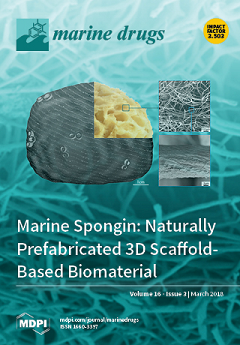The aim of the present study was to investigate the neuro-soothing activity of a water-soluble hydrolysate obtained from the red microalgae
Rhodosorus marinus Geitler (Stylonemataceae). Transcriptomic analysis performed on ≈100 genes related to skin biological functions firstly revealed that the crude
Rhodosorus marinus
[...] Read more.
The aim of the present study was to investigate the neuro-soothing activity of a water-soluble hydrolysate obtained from the red microalgae
Rhodosorus marinus Geitler (Stylonemataceae). Transcriptomic analysis performed on ≈100 genes related to skin biological functions firstly revealed that the crude
Rhodosorus marinus extract was able to significantly negatively modulate specific genes involved in pro-inflammation (interleukin 1α encoding gene, IL1A) and pain detection related to tissue inflammation (nerve growth factor NGF and its receptor NGFR). An in vitro model of normal human keratinocytes was then used to evaluate the ability of the
Rhodosorus marinus extract to control the release of neuro-inflammation mediators under phorbol myristate acetate (PMA)-induced inflammatory conditions. The extract incorporated at 1% and 3% significantly inhibited the release of IL-1α and NGF secretion. These results were confirmed in a co-culture system of reconstructed human epithelium and normal human epidermal keratinocytes on which a cream formulated with the
Rhodosorus marinus extract at 1% and 3% was topically applied after systemic induction of neuro-inflammation. Finally, an in vitro model of normal human astrocytes was developed for the evaluation of transient receptor potential vanilloid 1 (TRPV1) receptor modulation, mimicking pain sensing related to neuro-inflammation as observed in sensitive skins. Treatment with the
Rhodosorus marinus extract at 1% and 3% significantly decreased PMA-mediated TRPV1 over-expression. In parallel with these biological experiments, the crude
Rhodosorus marinus extract was fractionated by centrifugal partition chromatography (CPC) and chemically profiled by a recently developed
13C NMR-based dereplication method. The CPC-generated fractions as well as pure metabolites were tested again in vitro in an attempt to identify the biologically active constituents involved in the neuro-soothing activity of the
Rhodosorus marinus extract. Two active molecules, namely, γ-aminobutyric acid (GABA) and its structural derivative GABA-alanine, demonstrated a strong capacity to positively regulate skin sensitization mechanisms related to the TRPV1 receptors under PMA-induced inflammatory conditions, therefore providing interesting perspectives for the treatment of sensitive skins, atopia, dermatitis, or psoriasis.
Full article






